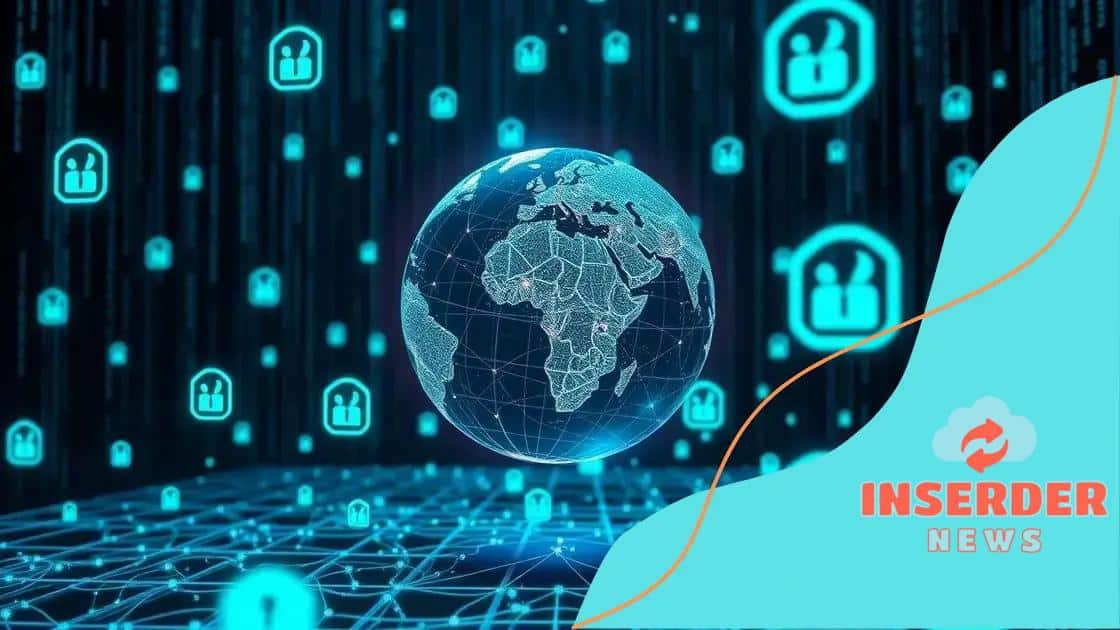Global disinformation control measures: how to tackle the challenge

Global disinformation control measures involve strategies and technologies that identify, combat, and reduce the spread of false information, ensuring public access to accurate and trustworthy content.
Global disinformation control measures are increasingly important as we navigate a world full of misleading information. Have you ever considered how misinformation might shape your opinions? Let’s dive into the effective strategies being implemented.
Understanding disinformation in the digital age
In today’s world, disinformation has become a significant concern. Understanding it is essential as we navigate the digital landscape filled with conflicting messages. With the rise of social media and the internet, false information spreads rapidly and can influence public opinion.
The nature of disinformation
Disinformation refers to false or misleading information designed to deceive. It is different from mere misinformation, which can be an honest mistake. Disinformation often has an agenda, aiming to manipulate or influence.
How disinformation spreads
The digital age has given rise to several channels that facilitate the quick spread of disinformation. These include:
- Social media platforms: Sites like Facebook and Twitter make it easy to share information, but this also allows false information to go viral.
- Websites and blogs: Not all sources are credible, and many exist solely to promote disinformation.
- Online communities: Forums and groups can amplify misleading narratives, creating echo chambers that reinforce false beliefs.
Combatting disinformation requires vigilance and awareness. It’s important to question the sources of information we consume. Think critically and verify facts before sharing anything online. Always consider the intent behind the information being presented.
The consequences of disinformation
Disinformation can have serious effects on society. It can lead to public panic, sway elections, and create division among communities. Understanding these impacts can help us recognize the importance of addressing disinformation effectively.
By educating ourselves and promoting media literacy, we can contribute to a healthier information environment. This not only aids in reducing the spread of disinformation but also encourages a more informed public capable of critical thought.
Key strategies for global disinformation control
Tackling global disinformation requires a multi-faceted approach. Several strategies can effectively combat this pervasive problem. These strategies often involve collaboration among various sectors, including government, technology companies, and the public.
Implementing educational programs
One of the first steps in controlling disinformation is to educate the public. Educational programs can help individuals recognize the signs of misleading information. It is vital to promote critical thinking skills, enabling people to question sources and verify facts.
Utilizing technology and algorithms
Technology plays a significant role in curbing disinformation. Here are some ways it can be used:
- Automated fact-checking: Advanced algorithms can help identify and flag false content across platforms.
- Content moderation: Social media companies can employ teams and AI to remove or reduce the visibility of disinformation.
- Data analytics: Analyzing patterns of information spread can inform strategies to counteract false narratives effectively.
Collaborative efforts among tech companies, government agencies, and fact-checkers are crucial. By sharing resources and knowledge, these organizations can enhance their ability to detect and counter disinformation.
Promoting transparency
Transparency is critical in building trust with the public. By being open about how information is moderated and how algorithms work, companies can alleviate concerns regarding bias and censorship. This transparency fosters user confidence and encourages individuals to engage with information critically.
Engaging with communities also helps address disinformation. Encouraging conversations and feedback enhances understanding and appreciation of differing perspectives. Building relationships with influencers can also amplify the dissemination of accurate information.
The role of technology in combating false information

Technology plays a vital role in combating false information in our digital age. Innovative tools and systems are being developed to help identify and reduce the spread of misleading content. With the rapid dissemination of information online, the need for technological solutions has never been more critical.
Automated Detection Systems
Many organizations are using automated systems to flag potential disinformation. These systems analyze content for patterns often associated with false narratives. For instance, algorithms can:
- Scan social media: They quickly identify misleading posts based on user engagement and flag them for review.
- Monitor websites: Automated tools check for red flags in articles, such as sensational headlines or lack of credible sources.
- Utilize machine learning: Over time, these systems learn to recognize various forms of false information.
Such technologies can help platforms manage the vast amount of content shared daily, making it easier to keep users informed while reducing exposure to misleading information.
Blockchain for Transparency
Blockchain technology is emerging as a solution for ensuring transparency in information sharing. By recording transactions on a secure and immutable ledger, blockchain allows users to verify the origin of information. This feature is crucial in building trust among users who often encounter disinformation.
Moreover, media organizations can leverage blockchain to provide clear, verifiable paths for their content. This not only reduces the chances of false information but also enhances accountability.
The collaboration between technology companies and researchers has brought forth numerous initiatives aimed at improving the reliability of online information. By enhancing user experience and restoring trust, technology can serve as a powerful ally in the fight against false information.
How governments and organizations are responding
Governments and organizations have recognized the threat of disinformation and are taking various steps to address it. Their responses are crucial in maintaining public trust and ensuring the integrity of information shared with citizens.
Legislative Actions
Many governments are implementing new laws aimed at curbing false information. These laws often focus on:
- Transparency in advertising: Requiring platforms to disclose paid content and political ads.
- Accountability for platforms: Holding social media companies responsible for the content on their sites.
- Stricter penalties: Enforcing fines and penalties for those who spread harmful disinformation intentionally.
These actions aim to create a safer online environment and help users easily distinguish between factual content and misleading information.
Collaborative Efforts
Collaboration between governments and organizations is essential in the fight against disinformation. Various initiatives have been launched, bringing together experts from different fields. These collaborations often focus on:
- Research and development: Discovering new technologies that can help identify and combat false information.
- Public awareness campaigns: Educating citizens about disinformation and how to recognize it.
- Global partnerships: Sharing data and strategies internationally to create a unified response.
By pooling resources and knowledge, organizations can enhance their effectiveness in countering disinformation, leading to a more informed public.
Training and Support for Media Outlets
Governments are also providing training for media outlets to help them navigate the challenges posed by disinformation. This includes:
- Workshops and seminars: Equipping journalists with the tools to verify information effectively.
- Access to resources: Providing fact-checking tools and services to news organizations.
- Promoting ethical journalism: Encouraging high standards of reporting and accountability.
These efforts support the media’s role as a key player in informing the public and combating false information in society.
Future challenges and solutions in disinformation control
Future challenges in disinformation control are likely to be complex. As technology evolves, so do the methods used to spread false information. To effectively combat these challenges, we need to stay proactive and innovative.
Evolving Techniques of Disinformation
One of the biggest hurdles is the rapid evolution of tactics used by those who create and spread misleading content. These include:
- Deepfakes: Technology that can create realistic fake videos and audio, making it harder for people to distinguish fact from fiction.
- Automated bots: Bots can quickly share and amplify fake news across platforms, reaching large audiences in a short time.
- Targeted misinformation: Tailoring messages to specific demographics increases the likelihood of disinformation being accepted as truth.
Recognizing these techniques is essential for developing strategies to combat them effectively.
Technological Solutions Ahead
To tackle the challenges presented by advanced disinformation tactics, we must invest in technology and research. Futuristic solutions might include:
- Enhanced AI algorithms: These can analyze vast quantities of data in real-time to identify and flag suspicious posts quickly.
- Better user reporting tools: Empowering users with easy-to-use tools for reporting misleading information can foster community involvement.
- Collaborative platforms: Building partnerships between tech companies, government bodies, and researchers can lead to shared insights and improved strategies.
Implementing these solutions will require collaboration and commitment from various stakeholders, including government, tech companies, and the public.
Building Public Resilience
Educating the public to recognize and critically evaluate disinformation is essential. Future solutions need to focus on:
- Media literacy programs: Teaching individuals how to distinguish between credible and non-credible sources.
- Community engagement: Encouraging discussions around disinformation to foster critical thinking within communities.
- Transparency initiatives: Promoting transparency in how information is collected, analyzed, and shared.
These efforts can empower individuals, making them more resilient against disinformation campaigns.
In conclusion, effectively addressing disinformation requires a collective effort from governments, organizations, and individuals. As we’ve seen, the evolving tactics of those spreading false information pose a significant challenge. However, with the right combination of technology, education, and collaboration, we can strengthen our defenses against misleading content. Moving forward, it’s essential to promote media literacy and transparency while leveraging innovative solutions to create a more informed society. Together, we can build resilience and trust in the information we consume.
FAQ – Frequently Asked Questions about Global Disinformation Control
What are disinformation control measures?
Disinformation control measures include strategies and technologies designed to identify, combat, and reduce the spread of false information.
How does technology help in combating disinformation?
Technology uses automated systems and algorithms to detect misleading content and flag it for review, enhancing the fight against false information.
Why is media literacy important?
Media literacy helps individuals critically evaluate information sources, which is essential in recognizing and rejecting disinformation.
What role do governments play in controlling disinformation?
Governments implement regulations, promote public awareness, and collaborate with organizations to develop effective strategies against disinformation.






